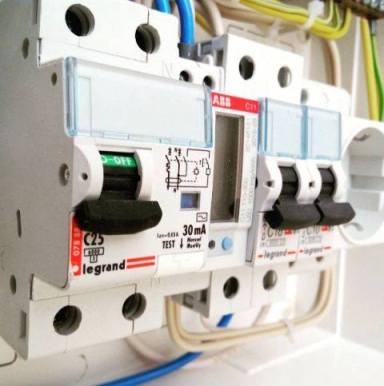Categories: Controversial issues, Automata and RCD
Number of views: 16085
Comments on the article: 2
RCD for lighting - to put or not?
The question of whether to install an RCD on the lighting circuit has recently been relevant. Meanwhile, there are no strict regulations regarding the installation of RCDs on lighting lines. Let's see what the RCD can give in this case, and how things will be without it. After which each reader will be able to conclude for himself whether to put the RCD on the lighting or not.

The principle of operation of the RCD
First, recall the principle of operation of the RCD. The differential current transformer inside the RCD allows you to detect the excess of the differential current. If such an excess occurs, the protected electrical circuit will open. RCD is included in the gap of the protected circuit - in the gap of the neutral and linear conductors.
After the RCD is put into operation, the contact inside it is closed by a solenoid, held in this state, and the device freely passes current through the supply circuit. If everything works fine no leaks, then the neutral conductor current and the linear conductor current are equal to each other, they are oppositely directed, and their magnetic fluxes in the core of the differential transformer coil are mutually compensated - EMF is not induced, there is no reason for the emergency opening of the RCD.

If there is now a short circuit or earth leak, the current of the linear conductor will be greater than the current of the neutral conductor - the magnetic fluxes in the core of the differential transformer will cease to be mutually compensated - EMF will be induced in the secondary winding of the transformer. The tracking device inside the RCD will detect this, and the solenoid will immediately cease to hold the contact - the circuit in which the leak is detected will be opened by the action of the spring on the contact for a split second, and the person will be cut off by current by the root.
Read more about the device and the principle of operation of the RCD see here:Types and types of RCDs, which RCDs exist and what is their difference
Conditional advantages of not installing an RCD on the lighting line
So, if you have not put an RCD on the lighting line, then what will it turn out to be? There are at least two advantages.
Firstly, you will save money on the purchase of an RCD, because a model of a well-known proven brand is not cheap, and if you buy an RCD, buy a quality one.
Secondly, you won’t take up extra space inside the shield, because even a single-phase RCD takes up two modules on a DIN rail, and sometimes there is a shortage of space in the shield, is it better to use it more expediently (depending on your priorities and current tasks )
Thus, if your budget, as well as the place inside the shield, is limited, then RCDs for lighting can not be set.
The obvious disadvantages of not installing an RCD on the lighting line
Cons in this situation is much harder than the pros. Many modern lighting devices have electrically conductive housings or at least conductive parts of the housings. When assembling such a device, a person may not notice how damaged insulation exposed the wire, and that one is already in contact with the housing somewhere inside the device.
What is this fraught with? The body of the lighting device (lamp, chandelier, lamp, sconce) can accidentally be energized, and when you try to screw in a light bulb or rub dust on a lamp shade, for example, a person will be shocked by electric shock.
The same is with cartridges: if a phase wire is attached to its external threaded part and a neutral wire is connected to the internal contact, the risk of electric shock increases, it is more correct to connect the phase wire to the central contact of the cartridge. In any case, even when replacing the light bulb, there is a risk of damage if you accidentally touch the thread. If an RCD is installed - the person will be protected, if there is no RCD - there is a risk.
A similar situation may arise in the case of repairs.When drilling a wall, you run the risk of accidentally stumbling a phase wire with a drill. If there is no protection, it may cause electric shock, not to mention a short circuit. If RCD is prudently installed, the circuit will instantly de-energize, and you will have time to fix the problem.
And in case of wet wiring or flooding? Here, an RCD ahead of a person will react to a dangerous situation - a wet section under voltage will be instantly de-energized, the danger of electric shock will be prevented. What to say about the bathroomWhere humidity is common? Here, protection of lighting lines by means of an RCD is extremely desirable.
The advantages of installing an RCD on the lighting line outweigh any objections
So, as you already understood, the advantages of installing an RCD are much more profitable than the advantages of not installing an RCD. By installing an RCD, having spent money and time once, you get a guarantee of protection against an accident and from electric shock. Thus, RCDs for lighting - definitely put!
Additionally on this topic:
See also at i.electricianexp.com
:
